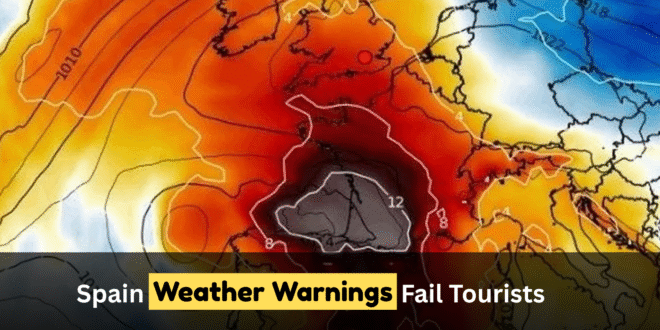1. Sudden Weather Shocks in Top Tourist Zones
The Balearic Islands, particularly Mallorca, Menorca, and Ibiza, experienced extreme flooding that stranded tourists in streets, hotels, and at airports. Water levels rose rapidly, overwhelming infrastructure and emergency services.
2. Inadequate Alerts for Non‑Spanish Speakers
Despite red, orange, and yellow alerts being issued by Spain’s national weather agency, many foreign visitors reported receiving no warnings in English or other languages.
>Some tourists suffered from dehydration, sunstroke, and dizziness due to the intense heat, while one Russian woman was critically injured after being struck by lightning during a storm in Valencia.
3. Infrastructure Impact and Emergency Responses
In Catalonia, torrential rains led to the evacuation of 71 patients from Penedès Regional Hospital after floodwaters threatened the building.
At Barcelona–El Prat Airport, terminals were flooded, causing delays and cancellations of flights and trains.
Spain’s Military Emergency Unit (UME) was deployed to assist rescue operations and manage the chaos across multiple regions.
4. Climate Double‑Threat: Heatwaves and Storms
Experts warned of a dangerous “climate double threat” as parts of Spain faced intense heat followed by sudden and violent storms.
>While the north and east saw heavy rain and flooding, southern areas such as Andalusia, Murcia, and Alicante battled extreme heat reaching 40–45 °C.
5. Questions Raised About Protection of Tourists
Spanish expects over 100 million foreign tourists this year, but the recent weather emergencies exposed serious gaps in the country’s readiness to protect non‑Spanish speakers.
The Spanish lack of translated alerts, public announcements, and app-based notifications in other languages left many tourists feeling vulnerable and unprepared for dangerous conditions.
FAQs
Q1: Why didn’t tourists receive proper warnings?
A: Most alerts were issued in Spanish only, and many tourists did not know how to access local emergency channels.
Q2: Which areas were affected the most?
A: Regions like Catalonia, Aragón, Valencia, and the Balearic Islands faced severe flooding, while southern Spain endured extreme heat.
Q3: Were there any injuries or fatalities?
A: One tourist was critically injured by lightning. Several others experienced medical issues due to heat and flooding, but no mass casualties have been reported.
Q4: What should tourists do during weather emergencies in Spain?
A: Stay indoors during alerts, follow embassy social media channels, use local weather apps, and ensure your hotel provides emergency info in your language.
Q5: How can Spain improve its tourist safety communication?
A: Authorities should issue multilingual alerts, improve signage, train hospitality staff on emergency procedures, and develop mobile alert systems tailored for foreign visitors.




